外研版英语九年级下册 Module 2 Education 模块复习课件(共85张PPT)
文档属性
| 名称 | 外研版英语九年级下册 Module 2 Education 模块复习课件(共85张PPT) | 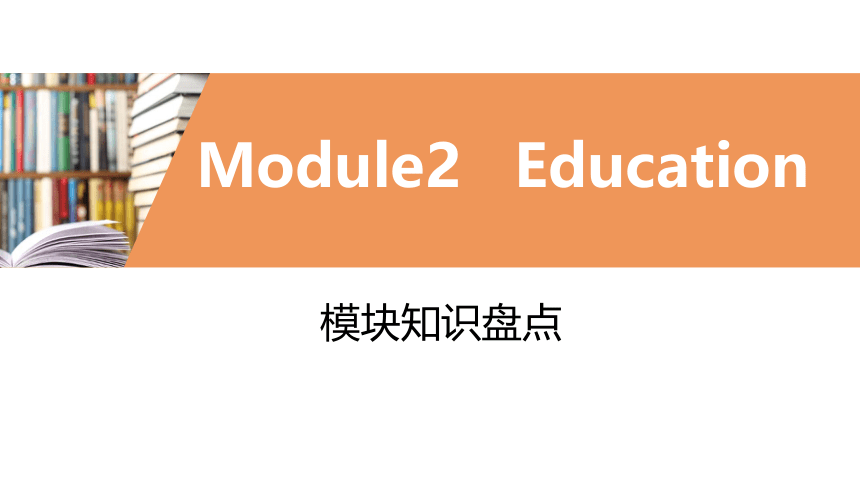 | |
| 格式 | pptx | ||
| 文件大小 | 415.4KB | ||
| 资源类型 | 教案 | ||
| 版本资源 | 外研版 | ||
| 科目 | 英语 | ||
| 更新时间 | 2022-08-29 17:19:43 | ||
图片预览




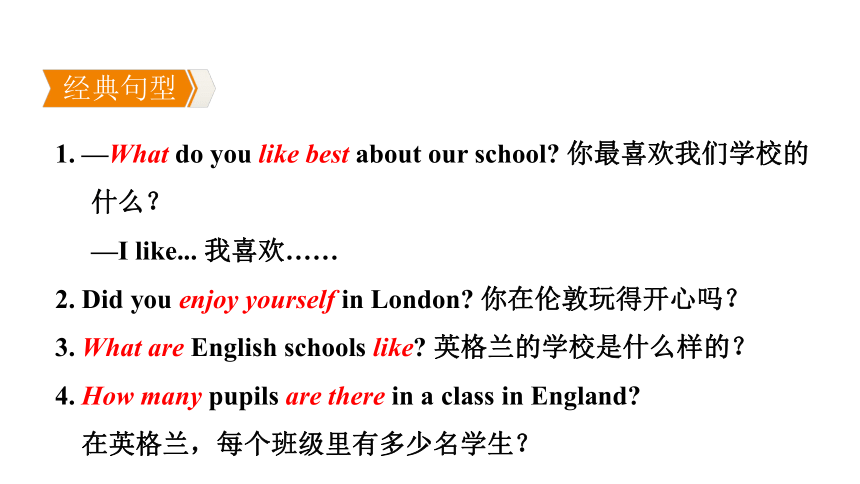
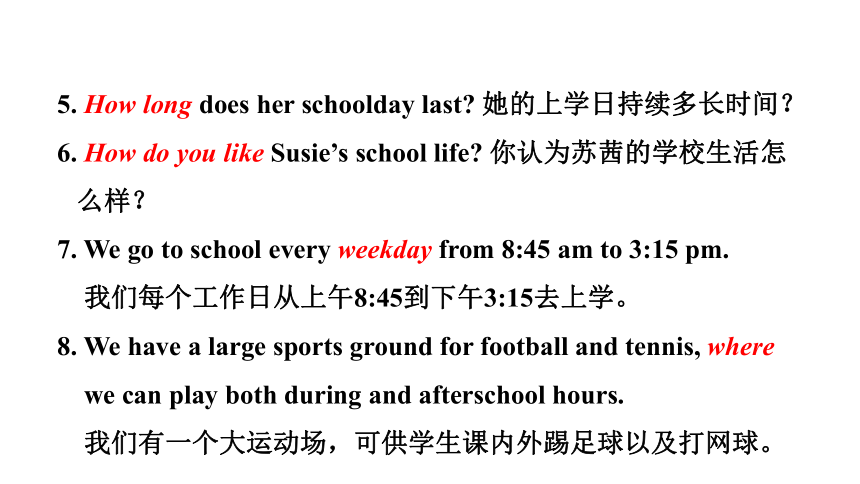
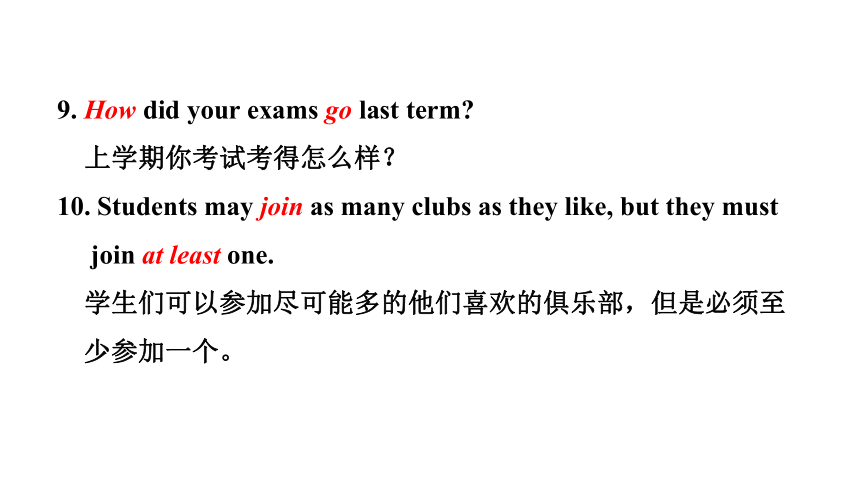
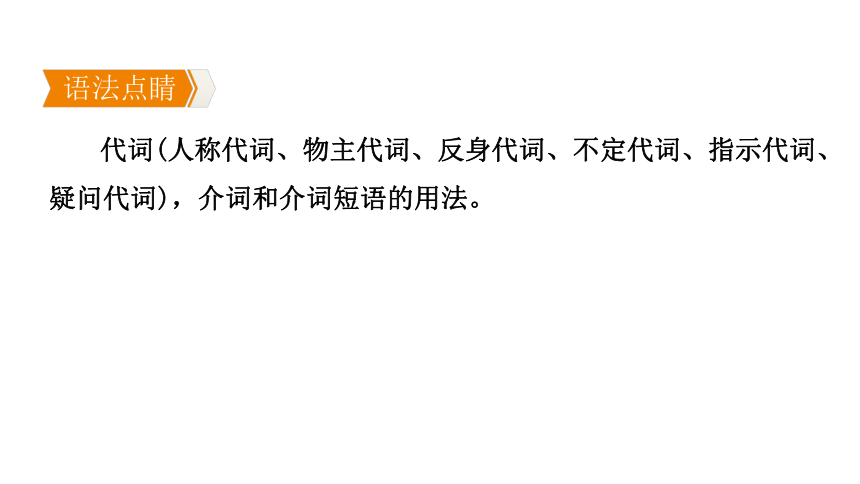
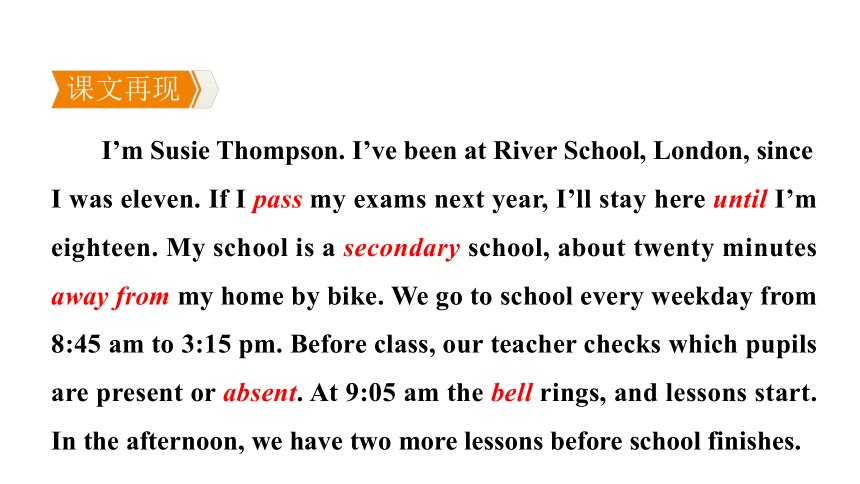

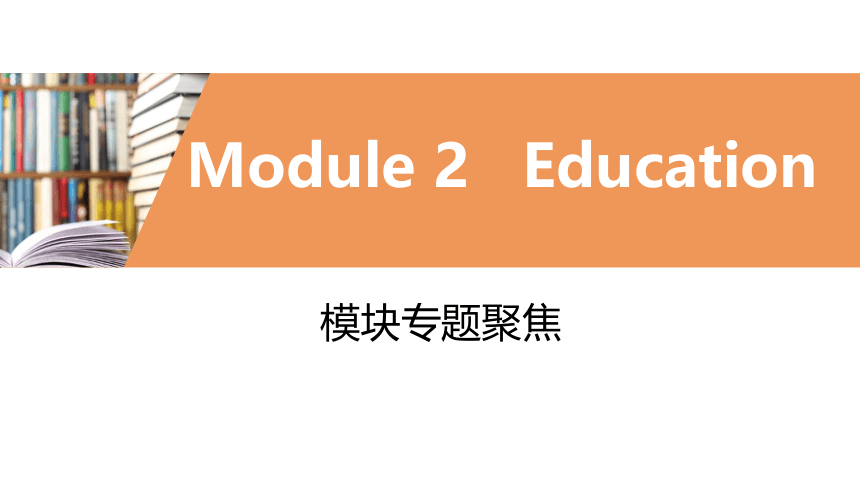

文档简介
(共85张PPT)
Module2 Education
模块知识盘点
常用短语
1. enjoy oneself 玩得开心 2. let sb. do sth. 让某人做某事
3. have a look 看一看 4. sit in rows 成排坐
5. one day 有朝一日 6. pass the exam 通过考试
7. secondary school 中学 8. by bike 骑自行车
9. last for 持续,维持 10. have a break 休息
11. instead of 代替;而不是 12. such as 例如
13. above all 最重要的是,尤其是
14. get good marks 取得好成绩
15. do well in... 在……方面做得好
16. ask for 请求;要求
17. each other 互相,彼此
18. be able to 能够
19. in between 在中间,当中
20. set up 建立,设立
21. to one’s surprise 令某人惊讶的是
22. teach oneself 自学
23. work on 从事,致力于
经典句型
1. —What do you like best about our school 你最喜欢我们学校的什么?
—I like... 我喜欢……
2. Did you enjoy yourself in London 你在伦敦玩得开心吗?
3. What are English schools like 英格兰的学校是什么样的?
4. How many pupils are there in a class in England
在英格兰,每个班级里有多少名学生?
5. How long does her schoolday last 她的上学日持续多长时间?
6. How do you like Susie’s school life 你认为苏茜的学校生活怎
么样?
7. We go to school every weekday from 8:45 am to 3:15 pm.
我们每个工作日从上午8:45到下午3:15去上学。
8. We have a large sports ground for football and tennis, where
we can play both during and afterschool hours.
我们有一个大运动场,可供学生课内外踢足球以及打网球。
9. How did your exams go last term
上学期你考试考得怎么样?
10. Students may join as many clubs as they like, but they must
join at least one.
学生们可以参加尽可能多的他们喜欢的俱乐部,但是必须至
少参加一个。
语法点睛
代词(人称代词、物主代词、反身代词、不定代词、指示代词、疑问代词),介词和介词短语的用法。
课文再现
I’m Susie Thompson. I’ve been at River School, London, since I was eleven. If I pass my exams next year, I’ll stay here until I’m eighteen. My school is a secondary school, about twenty minutes away from my home by bike. We go to school every weekday from 8:45 am to 3:15 pm. Before class, our teacher checks which pupils are present or absent. At 9:05 am the bell rings, and lessons start. In the afternoon, we have two more lessons before school finishes.
This year I have ten subjects. It’s lucky we don’t have exams in every subject. During the school year there are usually visits to museums and to camps for activities such as climbing and walking in the country. Once a term, there’s a parents’ meeting, so our parents and teachers can talk about our progress.
Module 2 Education
模块专题聚焦
巧品语法
语法精讲
代词、介词和介词短语
命题情报
1. 代词是中考常考点之一。
代词主要包括人称代词、物主代词、反身代词、不定代词、疑问代词等。从历年中考命题趋势看,考试范围多集中在以下几个方面:
人称代词;名词性物主代词和形容词性物主代词的用法与区别;反身代词;不定代词及常见不定代词如some,any,both,either,neither,other,another,others的辨析;指示代词;疑问代词; it,one,that等的辨析。代词的考查题型很多,单项选择、完形填空、阅读理解中都会涉及,是中考的考查热点之一。
2. 介词的用法非常广泛,介词表示时间、地点、方位、方式的用法是中考的常见考点。另外常用的介词搭配也是中考的考查热点之一。
1代词
1. 人称代词
(1)人称代词为指代人或事物的代词(如你、我、他等),分为主格和宾格两种形式。
主格 宾格
单数 I, you, he, she, it me, you, him, her, it
复数 we, you, they us, you, them
功能 作主语 作 及 物 动 词 、 介 词的宾语或be动词的表语;在省略句中表示相同的情况。
She is a singer. (主格)她是一名歌手。
I can play the guitar. (主格)我会弹吉他。
—We don’t know him. (宾格)我们不认识他。
—Me neither. 我也不认识。
(2)人称代词的语序
多个人称代词并列充当主语时,它们的顺序如下:
单数形式:you, he/she and I(二、三、一)
复数形式:we, you and they(一、二、三)
(3)it的用法
①作人称代词的用法
a. it 作人称代词,可以指除人以外的一切事物或动物。
This is a watch. It is new.这是一块手表,它是新的。
b. it也可指人,主要用于指代性别不明的婴儿或用于确认某人的身份。
Is it a boy or a girl 是一个男孩还是一个女孩?
There is a knock on the door. It must be the postman.
有人在敲门,一定是邮递员。
[注意] 在答语中,it常用来指本人,如:It’s me.
c. it还可用于代替指示代词this, that以及复合不定代词something, anything, nothing等。
—What’s this 这是什么?
—It’s a new machine. 是一种新机器。
Nothing is wrong, is it 没出什么问题,是吗?
②作非人称代词的用法
a. it主要用于指时间、距离、价值、天气、气候及温度等。
It’s too late to go there now. 现在去那儿太迟了。
b. 用于某些固定句型
It’s time for sth. 该做某事了。
It’s time (for sb.) to do sth. 到(某人)做某事的时候了。
It’s (about/high) time+that从句. 现在是……的时候了。
(从句谓语动词用过去式,有时也用“should+动词原形”)
It’s the first/second time+that从句.
某人第一/二次做某事。(从句用现在完成时)
It’s+时间段+since从句.
自从……有多长时间了。
It’s+时间段+before从句. 过多长时间才……
③it用作形式主语,常用句型如下:
It+be+adj.+for/of sb. to do sth.
某人做某事……
It takes sb.+时间段+to do sth.
某人做某事花了……时间。
④it用作形式宾语,常用结构:主语+谓语+it+宾语
补足语+不定式(动名词或从句)
I find it difficult to do the job well.
我发现做好这项工作不容易。
We think it no use complaining.
我们认为抱怨是没有用的。
I think it best that you should stay here.
我认为你最好待在这儿。
人称 形容词性物 主代词 名词性物主代词 含义
单 数 第一人称 my mine 我的
第二人称 your yours 你的
第三人称 his his 他的
her hers 她的
its its 它的
2. 物主代词
复 数 第一人称 our mine 我们的
第二人称 your yours 你们的
第三人称 their theirs 他/她/它
们的
形容词性物主代词与名词性物主代词的区别:
May I use your pen Yours works better.
我可以用用你的钢笔吗?你的更好用。
形容词性物主代词 位于名词前,作定语,限定该名词的意义。
名词性物主代词 在句中充当主语、宾语或表语,相当于“形容词性物主代词+名词”,后面不能再跟名词。
3. 反身代词
反身代词是指某人自己,单数以-self结尾,复数以-selves结尾。第一、二人称反身代词由“形容词性物主代词+-self/-selves”构成,第三人称反身代词由“宾格人称代词+-self/-selves”构成。反身代词在句中常作宾语、同位语或表语。反身代词不能作主语。
人称 数 第一人称 第二人称 第三人称
单数 myself yourself himself,
herself, itself
复数 ourselves yourselves themselves
4. 不定代词
不明确指代某个(些)人、某个(些)事物的代词叫不定代词。不定代词在句中可以作主语、表语、宾语、定语、状语等。
不 定 代 词 肯定 性质 both, all, many, much, one, other, each,
another, either, a few, a little, some(someone, somebody, something,somewhere), any(anyone, anybody,anything, anywhere), every(everyone,everybody, everything, everywhere)
否定 性质 no, neither, none, nobody, nothing, few,little
(1)some与any的用法比较
some ①一般用在肯定句中,表示“一些,某些;某个”。
②也可用在疑问句中,希望得到对方的肯定回答或委婉提出建议与要求。
any ①一般用在否定句、疑问句及条件句中,表示“任何的,任一的”。
②也可用在肯定句中,表示“任何”。
(2)little, a little与few, a few的用法比较
some 修饰可数名词 修饰不可数名词
一些 a few a little 表示肯定含义
几乎 没有 few little 表示否定含义
(3)each, either, both, all, neither与none的用法比较
词条 含义 谓语动 词形式 功能 相同点
each 每一个(≥2) 单数 主语、宾语、 定语、同位语 ①都可
与of短语
either (两者中的) 任何一个 单数 主语、宾语、 定语 both (两者)都 复数 主语、宾语、 定语、同位语 连用且
在句中
主语;
②都能
单独作
主语。
all 都(≥3) 复数 主语、宾语、定语 、表语、同位语 neither (两者)都不 单数 主语、宾语、定语 none 都不(≥3) 单复数 均可 主语、宾语 5. 指示代词
单数 复数 用法
this these 一般用来指在时间或空间上较近的人或事物。
指下面将要讲到的事物。
that those 指 在 时 间 或 空 间 上 较 远 的 人 或事物。
指前面讲到过的事物。
有时为了避免重复提到某一名词,常用that或those代替。
Toys! These are my toys!
玩具!这些是我的玩具!
What I want to say is this: pronunciation is veryimportant in learning English.
我想说的是:发音在英语学习中非常重要。
In those days the workers had a hard time.
在那些日子里,工人们过着艰苦的日子。
I had a cold. That’s why I didn’t come.
我感冒了。这就是我没来的原因。
指示代词和疑问代词
Television sets made in Beijing are just as good as
those made in Shanghai.
北京制造的电视机和上海制造的一样好。
疑问代词 含义 功能
who 谁 主语、表语、宾语
whom 谁 宾语(who的宾格)
whose 谁的 表语、定语(who的所有格)
what 什么 主语、表语、宾语、定语
which 哪个 主语、表语、宾语、定语
6. 疑问代词
Who are you waiting for 你正在等谁?
With whom did you go swimming 你和谁去游泳的?
Whose pen is this 这是谁的钢笔?
What do you know about it 你对它有什么了解?
Which movie do you like best 你最喜欢哪部电影?
2词和介词短语
介词是一种虚词,不能单独作句子成分,必须和其后的补足成分(又称“介词宾语”)一起构成介词短语才能用于句中。介词宾语可以是名词、代词、数词、动名词、从句等。
常见的“介词+名词”搭配:
after a while 片刻之后 after class 下课以后
along the road 沿路 at breakfast 早餐时
at home 在家 at last 终于;最后
at night 在夜里 at the bus stop 在公交车站
at the end of 在……末尾/尽头
at the head of 在……顶端/上端
at the moment 此刻 at the same time 同时
at times 有时;偶尔 by air/bus 乘飞机/公共汽车
by the door 在门口 by the end of 到……末
by the way 顺便说一下 during summer holidays 在暑假
from Monday to Friday 从周一到周五
from now on 从现在起 in a hurry 匆忙地
in bed (躺)在床上 in English 用英语
in fact 实际上;事实上 in the city 在城里
in the country 在乡下 in the daytime 在白天
in the east of 在……东部 in the end 最后
in the morning 在早晨 in the open air 在户外;露天
in this way 用这种方法 in time 及时
on display/show 陈列;展出
on duty 值班;值日 on foot 走路;步行
on Monday morning 在周一早晨
on the east of 在……东面(接壤)
on the left 在左边
on the other hand 另一方面
on time 按时;准时
to the east of 在……东面(不接壤)
with one’s help 在某人的帮助下
1. |阜康、米泉中考|Sometimes ______ turns off the lights in the classroom, because everybody thinks somebody will do it.
A. anybody B. somebody
C. nobody D. everybody
考点直击
C
2. |云南中考|—Which city would you like to live in,Beijing or Shanghai
— ______. I’d like to choose Kunming.
A. Either B. Both
C. Neither D. None
C
3. |长春中考|In 2022, Beijing will host the WinterOlympics. ______ my brother and I want to watchit.
A. Neither B. All
C. Either D. Both
D
4. |温州中考|—Did anyone call me when I was out
—Yes. A man who called ______ Tom.
A. myself B. himself
C. herself D. yourself
B
【解析】考查反身代词。句意:“我不在家时,有人给我打电话吗 ”“有。一位自称汤姆的男士。”故选B。
5. |荆门中考|—Do you know who taught ______ French
—Nobody. He learned it by ______.
A. his; himself B. him; him
C. him; himself D. his; him
C
【解析】 taught为动词teach的过去式,后跟人称代词宾格him作宾语;by oneself为固定结构,意为“独自”。故选C。
6. |黄冈中考|—Everyone knows Canada is the secondlargest country in the world.
—That is, it is larger than ______ country in Asia.
A. any B. any other
C. other D. another
A
7. |兰州中考|Bill thought ______ necessary to work with friends and share different ideas.
A. it B. they
C. them D. him
A
【解析】 “sb. thinks it+adj.+to do sth.”是固定句型,其中it为形式宾语,真正的宾语是后面的动词不定式。
8. |昆明中考|—Where would you like to go this Mid-Autumn Festival
—I’d like to go ______.
A. everywhere relaxing B. somewhere relaxing
C. peaceful anywhere D. peaceful somewhere
B
【解析】 形容词修饰不定代词或副词时应后置。
9. |达州中考|—What about these two coats, madam
— ______of them fits me. Could you show me ______ one
A. Either; other B. Neither; another
C. Neither; else D. Either; another
B
【解析】考查不定代词的辨析。根据第一句中的“two”可知谈到两者;根据语境可知,想要看另外一件,这两件都不合适,故选neither;another指“另一个”。故选B。
10. |福州中考| —Jane, is this your umbrella
—No, it’s not ______ . I didn’t take one thismorning.
A. me B. my C. mine
C
【解析】 句意:“简,这是你的雨伞吗 ”“不,不是我的。我今天早上没有带伞。”由语境可知设空处指“我的雨伞”,所以用名词性物主代词mine。故选C。
11. |青岛中考|—Can I come today or tomorrow
— ______is OK. I’m busy today and tomorrow.
A. Either B. Neither
C. Each D. None
B
【解析】考查代词用法。句意:“我是今天来还是明天来呢 ”“ 可以。我今明两天都忙。”either意为“两者中的任意一个”;neither意为“两者都不”;each意为“每一个”;none意为“没有一个”。根据答语可知,“我今明两天都忙”,故哪天都不行。故选B。
12. |南京中考|—What would you like to drink
—I’m very thirsty. ______ you can get. Just get it now.
A. Anything B. Something
C. Nothing D. Other things
A
【解析】 句意:“你想喝什么 ”“我很渴,任何你能找到的喝的,现在拿来给我。”在肯定句中,anything表示“任何东西”。
13. |宜宾中考| There are enough cups for each visitor to have ______.
A. one B. it
C. this D. that
A
【解析】 one与it都可替代上文出现的某个名词,但用法不同。one用来指代上文出现的某类事物中的一个,it指代上文中出现的那个东西。由语境可知此处表示同类事物中的一个,故选A。
14. |安徽中考| We can’t do it that way—but whether it will work is ______ matter.
A. other B. another C. each D. every
B
【解析】句意:我们不能那么做——不过它会不会起作用就是另一件事了。other后接名词复数,表示泛指,意为“其他的”;another意为“另一个,再一个”,后接名词单数,指在原来的基础上增加一个;each意为“每一个”,侧重个体,后接名词单数;every意为“每一个”,后接名词单数,指整体中的每一个。结合句意可知此处指“另外的一件事情”,故选B。
15. |连云港中考| —The population of China is larger than ______ of India.
—Yes, but India’s population is increasing rapidly.
it B. one
C. that D. this
C
16. |随州中考|—Do you know the student ______ David and Jack
—Yeah. It’s Jim.
among B. in
C. between D. around
17. |资阳中考| When I got into the room, Green was talking
______ the phone.
A. on B. with
C. to D. in
C
A
18. |日照中考| His opinions are similar ______ yours but different Julia’s.
A. to; from B. from; to
C. as; with D. with; as
A
【解析】 句意:他的观点和你的类似,但和朱莉娅的不同。be similar to意为“和……相似”,be different from意为“和……不同”。故选A。
19. |重庆中考|—What time do you usually go to school, Jack
— ______about half past seven.
A. On B. In
C. At D. For
20. |杭州中考|They usually go shopping ______ their lunch break.
A. against B. among
C. between D. during
C
D
描述学校生活
本模块以“学校生活”为话题,命题形式主要是围绕最喜欢的科目和时刻安排等主题展开。常见的命题形式:介绍自己最喜欢的科目、叙述自己一天的课程安排、介绍中学校园生活以及就学校生活发表自己的看法等。
妙解写作
写 作 案 例
|泸州中考|请根据要点提示用英语写一篇短文,向你的朋友们简述你在学校一天的学习和生活情况。
要点提示:
1. 早上:起床,晨练,早餐;
2. 上午:上课时间、节数,午餐;
3. 下午:上课时间、节数,课后体育活动;
4. 晚上:读书,写作业,睡觉。
注意:
1. 词数100左右,短文的首句已给出,不计入总词数;
2. 要点提示均须涉及,可适当增加内容;
3. 字迹工整,文意连贯,语言流畅;
4. 不用真实姓名、校名、地名。
My Schoolday
Now let me tell you something about my everyday school life. ___________________________________________________________________________________________________________________________________________________________________________ __________________________________________________________________________________________________________________
素 材 积 累
词汇库
present 出席的
absent 缺席的
everyday 日常的
start 开始
last 持续
rich 丰富的
短语箱
do morning exercises 晨练
get up 起床 have classes 上课
after-school activities 课外活动
take exams in 参加……考试
do some reading 阅读
do one’s homework 写作业
go to bed 睡觉
句式链
① My favourite subject is... 我最喜欢的课程是……
② I like it because... 我喜欢它是因为……
③ After-school activities, such as...are very popular at our school. 课外活动,如……在我们学校很受欢迎。
④ It’s about...minutes from my home to school.
从我家到学校大约要……分钟。
⑤ I’ll tell you something about my school life.
我将告诉你一些有关我的学校生活的事情。
⑥ I usually do many things such as...
我通常做很多事情,比如……
⑦ We go to school every weekday from...to...
我们每个工作日从……到……上学。
⑧ I take exams in..., but I don’t take exams in...
我要参加……考试,但是我不参加……考试。
五 步 妙 解
审
体裁 记叙文 话题 描述学校生活
时态 一般现在时 人称 第一人称
段落 布局 开头:概括介绍要写的内容。 主体:详细描述学校生活。 结尾:进行总括。 谴
(1)Every day I do morning exercises. I get up.
将以上两个句子用after合并为一个句子: _____________________________________________________
(2)我想它对我们的健康有益。
①我想: __________________________________________
②对我们的健康有益: ___________________________________
③翻译整句: ____________________________________________
I think
Every day I do morning exercises after I get up.
be good for our health
I think it’s good for our health.
模
总述
叙述一天的
学校生活
总括
Now let me tell you something about my everyday school life.
Every day I do morning exercises after I get up.
We often play volleyball with our classmates after
school.
I usually do some reading and do my homework
in the evening and then go to bed at about 9:00 pm.
What a busy day I have!
My Schoolday
Now let me tell you something about my everyday school life. Every day I do morning exercises after I get up, and then I have breakfast. We have four lessons in the morning and three in the afternoon. Our first lesson starts at 8:00 am and the fifth lesson starts at 2:00 pm. The food in ourschool dining hall is so delicious. We often play
润
volleyball with our classmates after school. I think it’s good for our
health. I usually do some reading and do my homework in the evening and then go to bed at about 9:00 pm.
What a busy day I have!
润
点
作者按照时间顺序叙述一天的学校生活,从早上起床,上午上课,到中午吃饭、休息,再到课后活动安排以及晚上读书、做作业、睡觉,整体上信息量比较大,细节也比较全面,将自己充实的一天呈现在我们面前。最后以感叹句结束,进行总结,整体行文流畅。
小 试 身 手
亲爱的同学们,初中生活即将结束,在老师的培养和同学的帮助下,你由一位懵懂少年成长为一名优秀的中学生。回顾三年的学校生活,难忘那生动有趣的课堂,难忘那丰富多彩的课外活动,也难忘那浓浓的师生情、同学情。离别在即,请对你的老师和同学说几句心里话,表达你真实的感受、由衷的感激和诚挚的祝福。
要求:
1. 词数80—100;
2. 不要逐句翻译;
3. 字迹工整,语言流畅,表达正确,逻辑清晰。
One possible version:
Hello, my dear teachers and friends.We have three fantastic years in our beautiful school. We have studied together and helped each other. We have made great progress.Thanks to my teachers and classmates, I’ve known not only how to study but also how to be a good person. I’ll never forget our interesting classes and all kinds of outdoor activities. I’ll never forget the good time we’ve spent together. I’ll remember our friendship forever.
Now, we’ll say goodbye to each other. I wish my teachers health and happiness. I wish my classmates to have a great future. And I also hope my school will be more and more beautiful.
“推理判断法”解阅读理解题
“推理判断法”即在理解原文表面信息的基础上,进行一定的推理和判断,从而得到文章的隐含意思和深层意义。做此类试题要注意两点:(1)与原文相同的细节不能选。因为此类题需要我们进行推理判断,忌原文呈现。(2)文章没有出现的细节不能跳出文章进行推断,即要忠于原文,切忌把自己的观点当成作者的观点。
培优课堂
【典例】
One morning Fan Xing discovered that her classroom had changed. The 13-year-old girl saw that the desks were no longer in rows(排), but pushed together to make six bigger desks.
The new arrangement(排列) was part of a reform(改革) at Fan’s school, Changsha Daotian Middle School in Hunan. About five weeks ago, more than 2,000 junior students at the school
began studying in this way, with six to eight students sitting in groups.
“This reform is designed to provide students with easier ways to study and more chances for discussion,” said Liu Xu, a school head teacher. “Our school hopes it can improve students’ abilities(能力) for self-study as well as teamwork.”
【题目】
The purpose of the new classroom arrangement is to ______.
A. make the students feel fresh and interested
B. divide big classes into small classes
C. make more room for new students
D. provide students with more chances for teamwork
【答案】 D
【解析】 本题考查教室内桌椅新的排列方式的目的。第一段和第二段介绍了这一排列,第三段介绍了这项改革的目的,选项D与之相符,所以选D。
谢 谢 观 看!
Module2 Education
模块知识盘点
常用短语
1. enjoy oneself 玩得开心 2. let sb. do sth. 让某人做某事
3. have a look 看一看 4. sit in rows 成排坐
5. one day 有朝一日 6. pass the exam 通过考试
7. secondary school 中学 8. by bike 骑自行车
9. last for 持续,维持 10. have a break 休息
11. instead of 代替;而不是 12. such as 例如
13. above all 最重要的是,尤其是
14. get good marks 取得好成绩
15. do well in... 在……方面做得好
16. ask for 请求;要求
17. each other 互相,彼此
18. be able to 能够
19. in between 在中间,当中
20. set up 建立,设立
21. to one’s surprise 令某人惊讶的是
22. teach oneself 自学
23. work on 从事,致力于
经典句型
1. —What do you like best about our school 你最喜欢我们学校的什么?
—I like... 我喜欢……
2. Did you enjoy yourself in London 你在伦敦玩得开心吗?
3. What are English schools like 英格兰的学校是什么样的?
4. How many pupils are there in a class in England
在英格兰,每个班级里有多少名学生?
5. How long does her schoolday last 她的上学日持续多长时间?
6. How do you like Susie’s school life 你认为苏茜的学校生活怎
么样?
7. We go to school every weekday from 8:45 am to 3:15 pm.
我们每个工作日从上午8:45到下午3:15去上学。
8. We have a large sports ground for football and tennis, where
we can play both during and afterschool hours.
我们有一个大运动场,可供学生课内外踢足球以及打网球。
9. How did your exams go last term
上学期你考试考得怎么样?
10. Students may join as many clubs as they like, but they must
join at least one.
学生们可以参加尽可能多的他们喜欢的俱乐部,但是必须至
少参加一个。
语法点睛
代词(人称代词、物主代词、反身代词、不定代词、指示代词、疑问代词),介词和介词短语的用法。
课文再现
I’m Susie Thompson. I’ve been at River School, London, since I was eleven. If I pass my exams next year, I’ll stay here until I’m eighteen. My school is a secondary school, about twenty minutes away from my home by bike. We go to school every weekday from 8:45 am to 3:15 pm. Before class, our teacher checks which pupils are present or absent. At 9:05 am the bell rings, and lessons start. In the afternoon, we have two more lessons before school finishes.
This year I have ten subjects. It’s lucky we don’t have exams in every subject. During the school year there are usually visits to museums and to camps for activities such as climbing and walking in the country. Once a term, there’s a parents’ meeting, so our parents and teachers can talk about our progress.
Module 2 Education
模块专题聚焦
巧品语法
语法精讲
代词、介词和介词短语
命题情报
1. 代词是中考常考点之一。
代词主要包括人称代词、物主代词、反身代词、不定代词、疑问代词等。从历年中考命题趋势看,考试范围多集中在以下几个方面:
人称代词;名词性物主代词和形容词性物主代词的用法与区别;反身代词;不定代词及常见不定代词如some,any,both,either,neither,other,another,others的辨析;指示代词;疑问代词; it,one,that等的辨析。代词的考查题型很多,单项选择、完形填空、阅读理解中都会涉及,是中考的考查热点之一。
2. 介词的用法非常广泛,介词表示时间、地点、方位、方式的用法是中考的常见考点。另外常用的介词搭配也是中考的考查热点之一。
1代词
1. 人称代词
(1)人称代词为指代人或事物的代词(如你、我、他等),分为主格和宾格两种形式。
主格 宾格
单数 I, you, he, she, it me, you, him, her, it
复数 we, you, they us, you, them
功能 作主语 作 及 物 动 词 、 介 词的宾语或be动词的表语;在省略句中表示相同的情况。
She is a singer. (主格)她是一名歌手。
I can play the guitar. (主格)我会弹吉他。
—We don’t know him. (宾格)我们不认识他。
—Me neither. 我也不认识。
(2)人称代词的语序
多个人称代词并列充当主语时,它们的顺序如下:
单数形式:you, he/she and I(二、三、一)
复数形式:we, you and they(一、二、三)
(3)it的用法
①作人称代词的用法
a. it 作人称代词,可以指除人以外的一切事物或动物。
This is a watch. It is new.这是一块手表,它是新的。
b. it也可指人,主要用于指代性别不明的婴儿或用于确认某人的身份。
Is it a boy or a girl 是一个男孩还是一个女孩?
There is a knock on the door. It must be the postman.
有人在敲门,一定是邮递员。
[注意] 在答语中,it常用来指本人,如:It’s me.
c. it还可用于代替指示代词this, that以及复合不定代词something, anything, nothing等。
—What’s this 这是什么?
—It’s a new machine. 是一种新机器。
Nothing is wrong, is it 没出什么问题,是吗?
②作非人称代词的用法
a. it主要用于指时间、距离、价值、天气、气候及温度等。
It’s too late to go there now. 现在去那儿太迟了。
b. 用于某些固定句型
It’s time for sth. 该做某事了。
It’s time (for sb.) to do sth. 到(某人)做某事的时候了。
It’s (about/high) time+that从句. 现在是……的时候了。
(从句谓语动词用过去式,有时也用“should+动词原形”)
It’s the first/second time+that从句.
某人第一/二次做某事。(从句用现在完成时)
It’s+时间段+since从句.
自从……有多长时间了。
It’s+时间段+before从句. 过多长时间才……
③it用作形式主语,常用句型如下:
It+be+adj.+for/of sb. to do sth.
某人做某事……
It takes sb.+时间段+to do sth.
某人做某事花了……时间。
④it用作形式宾语,常用结构:主语+谓语+it+宾语
补足语+不定式(动名词或从句)
I find it difficult to do the job well.
我发现做好这项工作不容易。
We think it no use complaining.
我们认为抱怨是没有用的。
I think it best that you should stay here.
我认为你最好待在这儿。
人称 形容词性物 主代词 名词性物主代词 含义
单 数 第一人称 my mine 我的
第二人称 your yours 你的
第三人称 his his 他的
her hers 她的
its its 它的
2. 物主代词
复 数 第一人称 our mine 我们的
第二人称 your yours 你们的
第三人称 their theirs 他/她/它
们的
形容词性物主代词与名词性物主代词的区别:
May I use your pen Yours works better.
我可以用用你的钢笔吗?你的更好用。
形容词性物主代词 位于名词前,作定语,限定该名词的意义。
名词性物主代词 在句中充当主语、宾语或表语,相当于“形容词性物主代词+名词”,后面不能再跟名词。
3. 反身代词
反身代词是指某人自己,单数以-self结尾,复数以-selves结尾。第一、二人称反身代词由“形容词性物主代词+-self/-selves”构成,第三人称反身代词由“宾格人称代词+-self/-selves”构成。反身代词在句中常作宾语、同位语或表语。反身代词不能作主语。
人称 数 第一人称 第二人称 第三人称
单数 myself yourself himself,
herself, itself
复数 ourselves yourselves themselves
4. 不定代词
不明确指代某个(些)人、某个(些)事物的代词叫不定代词。不定代词在句中可以作主语、表语、宾语、定语、状语等。
不 定 代 词 肯定 性质 both, all, many, much, one, other, each,
another, either, a few, a little, some(someone, somebody, something,somewhere), any(anyone, anybody,anything, anywhere), every(everyone,everybody, everything, everywhere)
否定 性质 no, neither, none, nobody, nothing, few,little
(1)some与any的用法比较
some ①一般用在肯定句中,表示“一些,某些;某个”。
②也可用在疑问句中,希望得到对方的肯定回答或委婉提出建议与要求。
any ①一般用在否定句、疑问句及条件句中,表示“任何的,任一的”。
②也可用在肯定句中,表示“任何”。
(2)little, a little与few, a few的用法比较
some 修饰可数名词 修饰不可数名词
一些 a few a little 表示肯定含义
几乎 没有 few little 表示否定含义
(3)each, either, both, all, neither与none的用法比较
词条 含义 谓语动 词形式 功能 相同点
each 每一个(≥2) 单数 主语、宾语、 定语、同位语 ①都可
与of短语
either (两者中的) 任何一个 单数 主语、宾语、 定语 both (两者)都 复数 主语、宾语、 定语、同位语 连用且
在句中
主语;
②都能
单独作
主语。
all 都(≥3) 复数 主语、宾语、定语 、表语、同位语 neither (两者)都不 单数 主语、宾语、定语 none 都不(≥3) 单复数 均可 主语、宾语 5. 指示代词
单数 复数 用法
this these 一般用来指在时间或空间上较近的人或事物。
指下面将要讲到的事物。
that those 指 在 时 间 或 空 间 上 较 远 的 人 或事物。
指前面讲到过的事物。
有时为了避免重复提到某一名词,常用that或those代替。
Toys! These are my toys!
玩具!这些是我的玩具!
What I want to say is this: pronunciation is veryimportant in learning English.
我想说的是:发音在英语学习中非常重要。
In those days the workers had a hard time.
在那些日子里,工人们过着艰苦的日子。
I had a cold. That’s why I didn’t come.
我感冒了。这就是我没来的原因。
指示代词和疑问代词
Television sets made in Beijing are just as good as
those made in Shanghai.
北京制造的电视机和上海制造的一样好。
疑问代词 含义 功能
who 谁 主语、表语、宾语
whom 谁 宾语(who的宾格)
whose 谁的 表语、定语(who的所有格)
what 什么 主语、表语、宾语、定语
which 哪个 主语、表语、宾语、定语
6. 疑问代词
Who are you waiting for 你正在等谁?
With whom did you go swimming 你和谁去游泳的?
Whose pen is this 这是谁的钢笔?
What do you know about it 你对它有什么了解?
Which movie do you like best 你最喜欢哪部电影?
2词和介词短语
介词是一种虚词,不能单独作句子成分,必须和其后的补足成分(又称“介词宾语”)一起构成介词短语才能用于句中。介词宾语可以是名词、代词、数词、动名词、从句等。
常见的“介词+名词”搭配:
after a while 片刻之后 after class 下课以后
along the road 沿路 at breakfast 早餐时
at home 在家 at last 终于;最后
at night 在夜里 at the bus stop 在公交车站
at the end of 在……末尾/尽头
at the head of 在……顶端/上端
at the moment 此刻 at the same time 同时
at times 有时;偶尔 by air/bus 乘飞机/公共汽车
by the door 在门口 by the end of 到……末
by the way 顺便说一下 during summer holidays 在暑假
from Monday to Friday 从周一到周五
from now on 从现在起 in a hurry 匆忙地
in bed (躺)在床上 in English 用英语
in fact 实际上;事实上 in the city 在城里
in the country 在乡下 in the daytime 在白天
in the east of 在……东部 in the end 最后
in the morning 在早晨 in the open air 在户外;露天
in this way 用这种方法 in time 及时
on display/show 陈列;展出
on duty 值班;值日 on foot 走路;步行
on Monday morning 在周一早晨
on the east of 在……东面(接壤)
on the left 在左边
on the other hand 另一方面
on time 按时;准时
to the east of 在……东面(不接壤)
with one’s help 在某人的帮助下
1. |阜康、米泉中考|Sometimes ______ turns off the lights in the classroom, because everybody thinks somebody will do it.
A. anybody B. somebody
C. nobody D. everybody
考点直击
C
2. |云南中考|—Which city would you like to live in,Beijing or Shanghai
— ______. I’d like to choose Kunming.
A. Either B. Both
C. Neither D. None
C
3. |长春中考|In 2022, Beijing will host the WinterOlympics. ______ my brother and I want to watchit.
A. Neither B. All
C. Either D. Both
D
4. |温州中考|—Did anyone call me when I was out
—Yes. A man who called ______ Tom.
A. myself B. himself
C. herself D. yourself
B
【解析】考查反身代词。句意:“我不在家时,有人给我打电话吗 ”“有。一位自称汤姆的男士。”故选B。
5. |荆门中考|—Do you know who taught ______ French
—Nobody. He learned it by ______.
A. his; himself B. him; him
C. him; himself D. his; him
C
【解析】 taught为动词teach的过去式,后跟人称代词宾格him作宾语;by oneself为固定结构,意为“独自”。故选C。
6. |黄冈中考|—Everyone knows Canada is the secondlargest country in the world.
—That is, it is larger than ______ country in Asia.
A. any B. any other
C. other D. another
A
7. |兰州中考|Bill thought ______ necessary to work with friends and share different ideas.
A. it B. they
C. them D. him
A
【解析】 “sb. thinks it+adj.+to do sth.”是固定句型,其中it为形式宾语,真正的宾语是后面的动词不定式。
8. |昆明中考|—Where would you like to go this Mid-Autumn Festival
—I’d like to go ______.
A. everywhere relaxing B. somewhere relaxing
C. peaceful anywhere D. peaceful somewhere
B
【解析】 形容词修饰不定代词或副词时应后置。
9. |达州中考|—What about these two coats, madam
— ______of them fits me. Could you show me ______ one
A. Either; other B. Neither; another
C. Neither; else D. Either; another
B
【解析】考查不定代词的辨析。根据第一句中的“two”可知谈到两者;根据语境可知,想要看另外一件,这两件都不合适,故选neither;another指“另一个”。故选B。
10. |福州中考| —Jane, is this your umbrella
—No, it’s not ______ . I didn’t take one thismorning.
A. me B. my C. mine
C
【解析】 句意:“简,这是你的雨伞吗 ”“不,不是我的。我今天早上没有带伞。”由语境可知设空处指“我的雨伞”,所以用名词性物主代词mine。故选C。
11. |青岛中考|—Can I come today or tomorrow
— ______is OK. I’m busy today and tomorrow.
A. Either B. Neither
C. Each D. None
B
【解析】考查代词用法。句意:“我是今天来还是明天来呢 ”“ 可以。我今明两天都忙。”either意为“两者中的任意一个”;neither意为“两者都不”;each意为“每一个”;none意为“没有一个”。根据答语可知,“我今明两天都忙”,故哪天都不行。故选B。
12. |南京中考|—What would you like to drink
—I’m very thirsty. ______ you can get. Just get it now.
A. Anything B. Something
C. Nothing D. Other things
A
【解析】 句意:“你想喝什么 ”“我很渴,任何你能找到的喝的,现在拿来给我。”在肯定句中,anything表示“任何东西”。
13. |宜宾中考| There are enough cups for each visitor to have ______.
A. one B. it
C. this D. that
A
【解析】 one与it都可替代上文出现的某个名词,但用法不同。one用来指代上文出现的某类事物中的一个,it指代上文中出现的那个东西。由语境可知此处表示同类事物中的一个,故选A。
14. |安徽中考| We can’t do it that way—but whether it will work is ______ matter.
A. other B. another C. each D. every
B
【解析】句意:我们不能那么做——不过它会不会起作用就是另一件事了。other后接名词复数,表示泛指,意为“其他的”;another意为“另一个,再一个”,后接名词单数,指在原来的基础上增加一个;each意为“每一个”,侧重个体,后接名词单数;every意为“每一个”,后接名词单数,指整体中的每一个。结合句意可知此处指“另外的一件事情”,故选B。
15. |连云港中考| —The population of China is larger than ______ of India.
—Yes, but India’s population is increasing rapidly.
it B. one
C. that D. this
C
16. |随州中考|—Do you know the student ______ David and Jack
—Yeah. It’s Jim.
among B. in
C. between D. around
17. |资阳中考| When I got into the room, Green was talking
______ the phone.
A. on B. with
C. to D. in
C
A
18. |日照中考| His opinions are similar ______ yours but different Julia’s.
A. to; from B. from; to
C. as; with D. with; as
A
【解析】 句意:他的观点和你的类似,但和朱莉娅的不同。be similar to意为“和……相似”,be different from意为“和……不同”。故选A。
19. |重庆中考|—What time do you usually go to school, Jack
— ______about half past seven.
A. On B. In
C. At D. For
20. |杭州中考|They usually go shopping ______ their lunch break.
A. against B. among
C. between D. during
C
D
描述学校生活
本模块以“学校生活”为话题,命题形式主要是围绕最喜欢的科目和时刻安排等主题展开。常见的命题形式:介绍自己最喜欢的科目、叙述自己一天的课程安排、介绍中学校园生活以及就学校生活发表自己的看法等。
妙解写作
写 作 案 例
|泸州中考|请根据要点提示用英语写一篇短文,向你的朋友们简述你在学校一天的学习和生活情况。
要点提示:
1. 早上:起床,晨练,早餐;
2. 上午:上课时间、节数,午餐;
3. 下午:上课时间、节数,课后体育活动;
4. 晚上:读书,写作业,睡觉。
注意:
1. 词数100左右,短文的首句已给出,不计入总词数;
2. 要点提示均须涉及,可适当增加内容;
3. 字迹工整,文意连贯,语言流畅;
4. 不用真实姓名、校名、地名。
My Schoolday
Now let me tell you something about my everyday school life. ___________________________________________________________________________________________________________________________________________________________________________ __________________________________________________________________________________________________________________
素 材 积 累
词汇库
present 出席的
absent 缺席的
everyday 日常的
start 开始
last 持续
rich 丰富的
短语箱
do morning exercises 晨练
get up 起床 have classes 上课
after-school activities 课外活动
take exams in 参加……考试
do some reading 阅读
do one’s homework 写作业
go to bed 睡觉
句式链
① My favourite subject is... 我最喜欢的课程是……
② I like it because... 我喜欢它是因为……
③ After-school activities, such as...are very popular at our school. 课外活动,如……在我们学校很受欢迎。
④ It’s about...minutes from my home to school.
从我家到学校大约要……分钟。
⑤ I’ll tell you something about my school life.
我将告诉你一些有关我的学校生活的事情。
⑥ I usually do many things such as...
我通常做很多事情,比如……
⑦ We go to school every weekday from...to...
我们每个工作日从……到……上学。
⑧ I take exams in..., but I don’t take exams in...
我要参加……考试,但是我不参加……考试。
五 步 妙 解
审
体裁 记叙文 话题 描述学校生活
时态 一般现在时 人称 第一人称
段落 布局 开头:概括介绍要写的内容。 主体:详细描述学校生活。 结尾:进行总括。 谴
(1)Every day I do morning exercises. I get up.
将以上两个句子用after合并为一个句子: _____________________________________________________
(2)我想它对我们的健康有益。
①我想: __________________________________________
②对我们的健康有益: ___________________________________
③翻译整句: ____________________________________________
I think
Every day I do morning exercises after I get up.
be good for our health
I think it’s good for our health.
模
总述
叙述一天的
学校生活
总括
Now let me tell you something about my everyday school life.
Every day I do morning exercises after I get up.
We often play volleyball with our classmates after
school.
I usually do some reading and do my homework
in the evening and then go to bed at about 9:00 pm.
What a busy day I have!
My Schoolday
Now let me tell you something about my everyday school life. Every day I do morning exercises after I get up, and then I have breakfast. We have four lessons in the morning and three in the afternoon. Our first lesson starts at 8:00 am and the fifth lesson starts at 2:00 pm. The food in ourschool dining hall is so delicious. We often play
润
volleyball with our classmates after school. I think it’s good for our
health. I usually do some reading and do my homework in the evening and then go to bed at about 9:00 pm.
What a busy day I have!
润
点
作者按照时间顺序叙述一天的学校生活,从早上起床,上午上课,到中午吃饭、休息,再到课后活动安排以及晚上读书、做作业、睡觉,整体上信息量比较大,细节也比较全面,将自己充实的一天呈现在我们面前。最后以感叹句结束,进行总结,整体行文流畅。
小 试 身 手
亲爱的同学们,初中生活即将结束,在老师的培养和同学的帮助下,你由一位懵懂少年成长为一名优秀的中学生。回顾三年的学校生活,难忘那生动有趣的课堂,难忘那丰富多彩的课外活动,也难忘那浓浓的师生情、同学情。离别在即,请对你的老师和同学说几句心里话,表达你真实的感受、由衷的感激和诚挚的祝福。
要求:
1. 词数80—100;
2. 不要逐句翻译;
3. 字迹工整,语言流畅,表达正确,逻辑清晰。
One possible version:
Hello, my dear teachers and friends.We have three fantastic years in our beautiful school. We have studied together and helped each other. We have made great progress.Thanks to my teachers and classmates, I’ve known not only how to study but also how to be a good person. I’ll never forget our interesting classes and all kinds of outdoor activities. I’ll never forget the good time we’ve spent together. I’ll remember our friendship forever.
Now, we’ll say goodbye to each other. I wish my teachers health and happiness. I wish my classmates to have a great future. And I also hope my school will be more and more beautiful.
“推理判断法”解阅读理解题
“推理判断法”即在理解原文表面信息的基础上,进行一定的推理和判断,从而得到文章的隐含意思和深层意义。做此类试题要注意两点:(1)与原文相同的细节不能选。因为此类题需要我们进行推理判断,忌原文呈现。(2)文章没有出现的细节不能跳出文章进行推断,即要忠于原文,切忌把自己的观点当成作者的观点。
培优课堂
【典例】
One morning Fan Xing discovered that her classroom had changed. The 13-year-old girl saw that the desks were no longer in rows(排), but pushed together to make six bigger desks.
The new arrangement(排列) was part of a reform(改革) at Fan’s school, Changsha Daotian Middle School in Hunan. About five weeks ago, more than 2,000 junior students at the school
began studying in this way, with six to eight students sitting in groups.
“This reform is designed to provide students with easier ways to study and more chances for discussion,” said Liu Xu, a school head teacher. “Our school hopes it can improve students’ abilities(能力) for self-study as well as teamwork.”
【题目】
The purpose of the new classroom arrangement is to ______.
A. make the students feel fresh and interested
B. divide big classes into small classes
C. make more room for new students
D. provide students with more chances for teamwork
【答案】 D
【解析】 本题考查教室内桌椅新的排列方式的目的。第一段和第二段介绍了这一排列,第三段介绍了这项改革的目的,选项D与之相符,所以选D。
谢 谢 观 看!
同课章节目录
